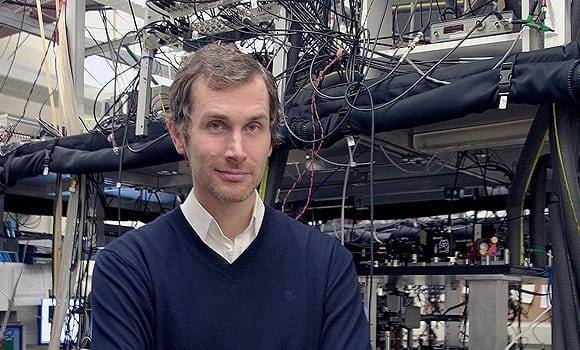
When one atom first meets another, the precise nature of that interaction can determine much about what kinds of physical properties and behaviours will emerge.
In a paper published today in Nature Physics, a team led by U of T physicist Joseph Thywissen reported their discovery of a new set of rules related to one particular type of atomic-pair interaction. The researchers study interactions between atoms that have been cooled close to absolute zero.
“Ultracold atoms are the stem cells of materials science,” says Thywissen, a Professor of Physics at the University of Toronto and also a Fellow of the Quantum Materials program at the Canadian Institute for Advanced Research. “Just as a stem cell can become a fingernail or a heart cell depending on its context, ultracold atoms can become metals, insulators, superfluids or other types of materials.”
In collaboration with theorists Shizhong Zhang of Hong Kong University and Zhenhua Yu of Tsinghua University, the Toronto experimentalists have been studying “p-wave interactions.” The term “p-wave” refers to the degree to which two atoms twirl around one another – a phenomenon physicists refer to as “angular momentum.”
Researchers study these interactions in a highly controlled environment, coaxing a few hundred thousand gas atoms into a “trap,” and cooling them to about -273 Celsius.
If two atoms hit head-on and bounce straight back from one another, it means they have no angular momentum. This interaction is called an s-wave. But if a pair of atoms ricochet off one another with a single unit of angular momentum, the resulting interaction is known as a p-wave.
P-waves, s-waves and other types of atom-pair interactions correlate with many types of emergent physical properties. Some rules that govern these relationships are well understood, but those related to p-waves have traditionally defied explanation.
“P-wave interactions fascinate scientists because they endow materials with unusual properties and puzzling behaviours,” says Thywissen. “But the conventional wisdom was that gases with p-wave interactions had losses that were too strong to allow you see anything interesting.”
Thywissen’s team employed a method called dynamical spectroscopy to prepare and probe atoms faster than had been done in the past.
“Our observations took less than a millisecond,” he says. “Previous studies were searching for properties that required longer observation. It allowed us to see something before the losses became too significant.”
Their orthodoxy-challenging experiments resulted more from serendipity than a conviction that there was a problem with conventional wisdom.
“We ended up looking at this because a junior graduate student working in our lab didn’t know to avoid the p-wave resonances. He took spectroscopy data on them,” Thywissen says. “Nature surprised us. There was a beautiful spectroscopic signal of a new kind of pressure that was due to p-wave interactions.”
Their subsequent observations sparked a flurry of activity among theoretical physicists, resulting in several new papers that attempted to explain this pressure. If correct, this theoretical work provides a new set of guidelines outlining how to understand any state of matter that emerges from p-wave interactions.
Learn more: PHYSICISTS DISCOVER NEW LAWS GOVERNING THE “DEVELOPMENTAL BIOLOGY OF MATERIALS”
The Latest on: Developmental biology of materials
[google_news title=”” keyword=”developmental biology of materials” num_posts=”10″ blurb_length=”0″ show_thumb=”left”]
via Google News
The Latest on: Developmental biology of materials
- Ruling: Iowa state auditor must provide more evidence to justify withholding emailson April 26, 2024 at 5:45 pm
The state auditor's office must do more to justify its decision to withhold from public release emails between his office and two journalists, the Iowa Supreme Court ruled.
- Researchers decipher how an enzyme modifies the genetic material in the cell nucleuson April 26, 2024 at 8:40 am
Inside the cell nucleus, the DNA molecule is found in a densely packed DNA-protein complex known as chromatin. Here the DNA is wrapped around a core of histone proteins and densely packed to form ...
- Genomic analysis of a species of zooplankton questions assumptions about speciation and gene regulationon April 26, 2024 at 6:40 am
When two animals look the same, eat the same, behave the same way, and live in similar environments, one might expect that they belong to the same species.
- Is the Steel Sports Watch Era Over? Here’s What the Data Sayson April 26, 2024 at 4:55 am
Long the dominant material, watchmakers seem to be pivoting away from the go-to metal. We crunched the numbers on 72 new watch releases to find out for certain.
- The Suicidal Lawyer Who Revolutionized Biologyon April 24, 2024 at 12:05 pm
Schwann was able to see the broader implications and formulate them in a systematic manner, which, elaborated by Virchow, was recognized by the scientific community and revolutionized biology. Get the ...
- Scientists unveil genetics behind development of glidingon April 23, 2024 at 5:00 pm
Researchers explain the genomic and developmental basis of the patagium, the thin skin membrane that allows some mammalian species to soar through the air.
- AI is boosting drug discovery and development — and sparking questions about proprietary dataon April 23, 2024 at 1:51 pm
AI and Biotech panel at Life Science Innovation Northwest 2024. From left: Danielle Greenawalt, Lynda Stuart, Sean McClain, Jonathan Cohen and moderator ...
- Pressure in the womb may influence facial developmenton April 23, 2024 at 10:49 am
Physical cues in the womb, and not just genetics, influence the normal development of neural crest cells, the embryonic stem cells that form facial features, finds a new study.
- Common Antibiotic Shows Promise in the Treatment of Respiratory Viral Infectionson April 23, 2024 at 2:08 am
Yale researchers say that nasal application of neomycin shows promise in the prevention and treatment of respiratory viral infections.
- Scientists Clone Two Black-Footed Ferrets From Frozen Tissues in Conservation Efforton April 22, 2024 at 1:43 pm
Researchers have cloned two black-footed ferrets from preserved tissue samples in an effort to conserve the creatures, the United States Fish and Wildlife Service announced last week. The animals are ...
via Bing News









